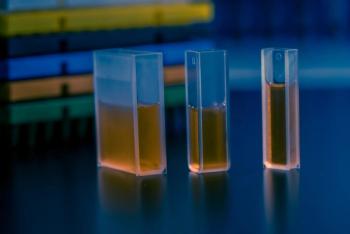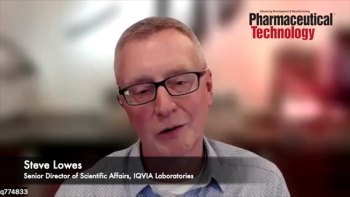
- Pharmaceutical Technology-03-02-2014
- Volume 38
- Issue 3
A New Approach to Forced Degradation Studies Using Anhydrous Conditions
In this article, the authors demonstrate that a normal-phase chromatographic method was stability-indicating for a water-sensitive prodrug. The stress conditions using aqueous and non-aqueous conditions were also compared to understand the information obtained with each approach.
Forced-degradation studies, or stress testing, of a drug substance are used to demonstrate the stability-indicating power of analytical procedures (1−5). While regulatory guidance documents emphasize the importance of these studies, the guidance does not specify pH, temperature ranges, specific oxidizing agents, or conditions to use. According to International Conference on Harmonization (ICH) Q1A (R2), the nature of the stress testing will depend on the individual drug substance (1). As such, the design of forced-degradation studies varies from company to company with general experimental designs focused on the four main pharmaceutically relevant degradation mechanisms: thermolytic, hydrolytic, oxidative, and photolytic (6−8). The choice of forced-degradation conditions is based on data from accelerated pharmaceutical studies and sound scientific understanding of the product’s decomposition mechanism (9−10). The experimental designs published to date, however, have only included entirely aqueous systems. The use of organic cosolvents is considered for cases where the drug substances are extremely insoluble, and inert organic cosolvents are selected to avoid reaction with the drug substance under a given set of stress conditions (5). In the case of a Type IIA prodrug (11), whereby water hydrolyzes the drug substance to give the active moiety, forced-degradation experiments using aqueous conditions will only give the degradation products for the active moiety. As a result, additional analytical methods must be used to characterize other potential degradants that could potentially form before hydrolysis of the drug substance to the active moiety. Alternatively, a single normal-phase chromatographic method could be employed where it was shown to be stability-indicating for the drug substance in the case of Type IIA prodrugs. The challenge for this approach is in demonstrating that the method is stability-indicating because traditional forced-degradation experiments, which use aqueous conditions, are incompatible. This article explores the technical challenges associated with conducting forced-degradation experiments under anhydrous conditions.
Anhydrous forced-degradation case study for C1
In this case study, drug substance C1 was used because it is classified as a Type IIA prodrug. The drug substance C1 hydrolyzes under aqueous conditions to give the biologically active species C2. When C1 is dissolved in anhydrous, aprotic solvents, the molecule remains in its original form. When dissolved in aqueous systems, however, C1 converts into C2 as described in Figure 1.
As the assay and impurity analysis of C1 is dependent on the solvent system, various analytical methods were developed to provide a complete analysis of the drug substance C1 and the active species C2. Forced-degradation studies were conducted on C1 using traditional aqueous conditions and analyzed by reversed-phase high-performance liquid chromatography (RP–HPLC). The degradation products found using this approach were the degradants of C2, the active species, but not the drug substance. Therefore, a second forced degradation study was conducted using anhydrous, reactive organic solutions and analyzed by normal-phase HPLC. The degradation products using this approach were degradants of both C1 and C2. By using anhydrous forced-degradation conditions, a normal-phase HPLC method was demonstrated to be stability-indicating for the drug substance.
Materials. C1 and C2 were synthesized by Millennium Pharmaceuticals (Cambridge, MA). Solvents and reagents, including anhydrous tetrahydrofuran (THF), non-anhydrous THF, hexane, pyridine, and trifluoroacetic acid (TFA) were all HPLC grade. The acetic acid, diisopropylamine and N,N-azobisisobutyronitrile (AIBN) used were analytical reagent grade. The cumene hydroperoxide used was technical grade (80%).
Instruments. The equipment included an Agilent 1100 HPLC equipped with a diode-array detector, chilled autosampler, online degasser, quaternary pump, and high-performance liquid chromatography-mass spectrometry. Photo-UV stability samples were stressed in a Suntest CPS chamber using a xenon lamp.
Method. The C1 drug substance and the active C2 species were separated by gradient using anhydrous (≤ 0.02% water) mobile phase on a cyano column. The sample was prepared by dissolving the C1 drug substance sample in an anhydrous (≤ 0.02% water) organic solvent mixture. The drug substance and active species were separated by the method and quantified by UV detection. The identity of C1 was confirmed by comparison of the C1 peak retention in the sample to that of the external C1 standard.
Degradation conditions. Degradation conditions evaluated included heat, acid, base, oxidation, and light. A stock solution of C1 was used to prepare each stressed solution. For each condition, a control without drug substance was included and treated the same way as the degraded samples. Photo controls included drug substance but were wrapped in aluminum foil to protect from light. The forced-degradation conditions used in this experiment (see Table I) include the following combinations:
- Control solution: 1 mg/mL C1 in 40/60 (v/v) anhydrous THF/hexane
- Heat solution: 1 mg/mL of C1 in 40/60 (v/v) anhydrous THF/hexane
- Acid solution: 0.1 N acetic acid in 40/60 (v/v) anhydrous THF/hexane
- Base solution: 0.0001 N diisopropylamine in 40/60 (v/v) anhydrous THF/hexane
- Oxidation solution: 0.1% cumene hydroperoxide in 40/60 (v/v) anhydrous THF/hexane
- Radical initiation solution: 10 mM AIBN in 40/60 (v/v) anhydrous THF/hexane
- Photo solution: 1 mg/mL of C1 in 40/60 (v/v) anhydrous THF/hexane.
Table I: Anhydrous forced-degradation results. THF is tetrahydrofuran, AIBN is N,N-azobisisobutyronitrile.
Degradation mechanism
Anhydrous solution
Stress condition
Stress time (hours)
% Degradation
Control
1 mg/mL API in 40/60 (v/v) anhydrous THF/hexane
Ambient
120
1.1
Heat
1 mg/mL API in 40/60 (v/v) anhydrous THF/hexane
60 ºC
24
17.4
Acid
1 mg/mL API and 0.1 N acetic acid in 40/60 (v/v) anhydrous THF/hexane
40 ºC
24
23.1
Base
1 mg/mL API and 0.0001 N diisopropylamine in 40/60 (v/v) anhydrous THF/hexane
5 ºC
1.2
5.0
Radical initiation
1 mg/mL API and 10 mM AIBN in 40/60 (v/v) anhydrous THF/hexane
40 ºC
120
19.0
Oxidation
1 mg/mL API in 0.1% cumene hydroperoxide in 40/60 (v/v) anhydrous THF/hexane
Ambient
120
4.6
Photo-UV
1 mg/mL API in 40/60 (v/v) anhydrous THF/hexane
UV radiation 765 W-hr/m2
120
21.3
Analytical considerations for study execution
In the case of aqueous forced degradation studies, most companies follow a standardized approach with pre-set conditions such as 0.1 N HCl or NaOH and a target drug substance concentration (6). In the case of this non-aqueous forced-degradation study, stress conditions required careful consideration with regard to drug solubility, reactivity with the drug substance, safety, and compatibility with the separation method and detection technique. For the prodrug C1, organic reagents needed to have ≤ 0.02% water present to prevent hydrolysis and maintain the form of the molecule. Mixtures of organic and aqueous solvents were, therefore, not appropriate.
Design of anhydrous conditions
The identification of reactive organic solvents/reagents with minimal water content included assessment of C1 solubility (see Table II), compatibility, chemical reactivity with the drug substance, and safety handling (see Table III). The criteria for good, fair, and poor was based on the feasibility of the experimentation. The drug substance solubility in the selected conditions was a crucial consideration because the drug substance was not soluble in many organic solvents. The drug substance was highly soluble in dimethyl sulfoxide (DMSO) and THF, which is why many of the systems considered contained these solvents. The normal-phase HPLC method diluent utilized a mixture of THF and hexane. As such, the HPLC diluent was a preferred solvent option for the anhydrous forced-degradation solution conditions. Another consideration was the miscibility of the solvent with the organic reactive reagent. In general, non-nucleophilic organic acids and bases were considered to avoid the potential hydrolysis of the drug substance. In addition, organic acids and bases that are commercially available, reasonably pure, and safe when heated were criteria used to select reagent candidates.
Table II: Solubility of C1 in anhydrous, aprotic solvents.
Solvent
Solubility (mg/mL)
Toluene
< 0.01
tert-Butylmethyl ether
< 0.01
Chloroform
< 0.01
Dichloromethane
< 0.01
Ethyl acetate
0.23
Isobutylmethyl ketone
0.30
Acetonitrile
1.5
2-Methyltetrahydrofuran
3.0
Dimethoxyethane
10
Acetone
13
Dioxane
31
Tetrahydrofuran
64
Dimethyl sulfoxide
> 400
Two different oxidative reagents were used in this study given that radical initiators and oxidative reagents can lead to different degradation products that may or may not be representative of the observed degradants for a product (12). Cumene hydroperoxide was chosen because it is a relatively stable organic peroxide, commercially available with reasonable purity, and readily soluble in organic solvents (13). The radical initiator, AIBN, was chosen because it can be a less reactive oxidant. Additionally, the use of THF in the AIBN stress solution helps to quench alkoxy radical activity that can interfere with the desired peroxy radical (autoxidative) chemistry (14). Interestingly, the same radical initiator reagent, AIBN, was used for anhydrous and aqueous forced-degradation experiments because it can be dissolved in both types of solvents. It also provided an opportunity for overlap in experimentation between the anhydrous and aqueous forced-degradation approaches.
Table III: Assessment and identification of reactive organic solvents/reagents for C1 forced-degradation experiments.
Degradation mechanism
Candidate solvent
C1 selection considerations1
Comments
Solubility
Reactivity
Compatibility
Safety
Acid
0.1 N, 0.5 N, or 1.0 N methanesulfonic acid in toluene2
Poor
Good
Poor
Fair
Toluene not compatible with HPLC mobile phase; toluene has chromaphore.
0.1 N, 0.5 N, or 1.0 N methanesulfonic acid in anhydrous THF
Good
Good
Good
Fair
Anhydrous THF used in HPLC mobile phase.
0.1 N, 0.5 N, or 1.0 N acetic acid in anhydrous THF
Good
Good
Good
Good
Acetic acid is a common reagent; available at time of study.
0.1 N, 0.5 N, or 1.0 N acetic acid in toluene
Poor
Good
Poor
Good
Toluene not compatible with HPLC mobile phase; toluene has chromaphore.
0.1 N, 0.5 N, or 1.0 N acetic acid in anhydrous THF/hexane
Good
Good
Good
Good
THF/hexane matches HPLC mobile phase.
0.1 N, 0.5 N, or 1.0 N acetic acid in DMSO
Good
Good
Fair
Good
DMSO is hygroscopic; risk of residual water content.
0.1 N, 0.5 N, or 1.0 N TFA in anhydrous THF
Good
Good
Fair
Fair
Difficult to obtain TFA free of contaminates.
0.1 N, 0.5 N, or 1.0 N formic acid in anhydrous THF
Good
Good
Poor
Good
Formic acid is mostly available in aqueous solution.
Base
Sodium ethoxide 21 weight % in ethanol2
Good
Good
Poor
Good
Ethanol will hydrolyze the API.
0.1 N, 0.5 N, or 1.0 N sodium ethoxide in anhydrous THF
Poor
Good
Poor
Good
Potential hydrolysis of API by ethoxide; sodium ethoxide solubility in THF is poor.
0.1 N, 0.5 N, or 1.0 N sodium ethoxide in toluene
Poor
Good
Poor
Good
Potential hydrolysis of API by ethoxide; toluene not compatible with HPLC mobile phase; toluene has chromaphore; sodium ethoxide solubility in toluene is poor.
0.1 N, 0.5 N, or 1.0 N pyridine in anhydrous THF
Good
Good
Poor
Good
HPLC UV interference in chromatogram.
0.1 N, 0.5 N, or 1.0 N pyridine in anhydrous THF/hexane
Good
Good
Poor
Good
HPLC UV interference in chromatogram; pyridine in THF/hexane resulted in a precipitate.
TEA in THF
Good
Good
Poor
Good
TEA interference at 220 nm (UV cut-off is 235 nm).
Diisopropylamine in THF/hexane
Good
Good
Good
Good
THF/hexane matches HPLC mobile phase.
Oxidation
1% cumene hydroperoxide in anhydrous THF
Good
Good
Good
Poor
Safe handling concern with using 100% THF since the potential for additional peroxides could be present.
1% cumene hydroperoxide in toluene
Poor
Good
Poor
Fair
Toluene not compatible with HPLC mobile phase; toluene has chromaphore.
1% cumene hydroperoxide in anhydrous THF/hexane
Good
Good
Good
Fair
THF/hexane matches HPLC mobile phase.
Hydrogen peroxide; t-butyl peroxide
Unknown
Good
Poor
Fair
Other peroxides are purchased in aqueous solutions.
Metal catalysts
Unknown
Good
Poor
Poor
Safe handling concern due to toxicity; sample preparation will likely involve filtering; metals may impact column.
Radical initiation
10 mM AIBN in anhydrous THF
Good
Good
Good
Poor
Safe handling concern with using 100% THF since the potential for additional peroxides could be present.
10 mM AIBN in anhydrous THF /hexane
Good
Good
Good
Fair
THF/hexane matches HPLC mobile phase.
Photo degradation
API dissolved in anhydrous THF/hexane
Good
Good
Good
Good
THF/hexane matches HPLC mobile phase.
Preliminary experiments
Preliminary forced-degradation studies were preformed to test the feasibility of the anhydrous forced-degradation approach. The drug substance was stressed in pure anhydrous THF at 60 °C. Due to safety concerns with oxidation and radical samples, samples for oxidation and radical stress were prepared in 40/60 THF/Hexane (to match the method mobile phase conditions) and stressed at lower temperatures, including 40 °C and ambient. At first, pyridine was used as the basic reagent, but this was replaced with diisopropylamine due to the broad baseline chromatographic interference observed with pyridine.
Based on the initial scouting stress conditions, optimized conditions (temperature and length of hold time) were used for the forced-degradation experiment on the C1 drug substance. The conditions were optimized to target 5% to 20% degradation of the main component. Generally, values anywhere between 5% to 20% degradation for the drug substance have been considered reasonable and acceptable for demonstrating specificity of chromatographic assays (15−17). In this case, a low concentration of diisopropylamine was needed to prevent excessive degradation of the main component. The results of the stress testing and overlay of chromatograms at the stress conditions are summarized in Table I and Figure 2.
Results and discussion
The anhydrous conditions for the C1 drug substance case study included conditions targeting the pharmaceutically relevant degradation mechanisms: acid, base, oxidation, photodegradation by UV, and radical initiation. The results of the anhydrous forced-degradation study for C1 are presented in Table I. The anhydrous solution used for each degradation condition is described along with the stress conditions and time applied. The amount of degradation in the solution was targeted at 5% to 20% C1, which is similar to the traditional forced-degradation approach using aqueous conditions. Representative chromatograms of some of the conditions are stacked with major degradation products labeled in Figure 2. Detection and peak identification was performed using photo diode array UV and/or mass spectrometry (5−8). The method was found to separate all C1 degradation products.
Using the anhydrous forced-degradation conditions, sufficient degradation of the C1 drug substance was achieved. Further analysis of the C1 samples stressed under anhydrous conditions was performed using mass spectrometry for major peak identification. The main degradation products from those anhydrous forced-degradation conditions were the hydrolysis degradation product and/or the oxidative degradation products. These degradation products were similar to the ones determined using traditional aqueous forced-degradation conditions; however, other degradation products were also observed in the anhydrous forced degradation conditions that were not observed in the aqueous forced-degradation study. Those additional impurities were identified and found to be additional degradation products of C1 that are detectable by the RP-HPLC method, but not routinely observed in release and stability testing because of the instability of the degradants in aqueous media.
In comparing the aqueous and anhydrous forced-degradation conditions for C1, a higher temperature was used to facilitate degradation under certain conditions to achieve the target degradation within a reasonable time. Different amounts of degradation for C1 were observed for both the aqueous and anhydrous studies, likely due to the type, strength, and mechanism of acid, base, oxidative, or light mediated degradation. Both approaches showed that the hydrolysis degradation product of C1 was the major degradant by heat, acid, and base degradation. Also, the oxidative degradation products of C1 were favored in the peroxide, radical initiated, and UV degradation samples. Both degradation approaches demonstrated that all relevant degradants of C1 result from the degradation of the active molecule, C2. As such, there were no new degradants identified in the anhydrous studies that were not accounted for in the aqueous study. However, exclusive to this approach, the anhydrous forced-degradation study identified moderate amounts of oxidative and hydrolytic degradation products of C1 that were otherwise transient and unstable in the aqueous stress conditions, although not pharmaceutically relevant. The anhydrous forced-degradation studies, therefore, may provide additional information to the aqueous studies traditionally performed for some molecules.
Another advantage includes the ability to better control the extent of degradation, and thus, more easily attain the target 5% to 20%. In the case of the C1 prodrug, the anhydrous forced-degradation study demonstrated that the normal-phase HPLC method was stability-indicating for the drug substance, hence, allowing a single analytical method to be used to characterize the stability of the prodrug.
Conclusion
Forced-degradation studies are crucial for demonstrating that drug-substance methods are stability-indicating. Traditional aqueous conditions may not be applicable for some molecules such as water sensitive prodrugs. Anhydrous conditions can be used in forced-degradation studies followed by normal-phase chromatography to demonstrate that the method is suitable for the determination of drug substance, impurities, and degradation products. Careful consideration must be given to the selection of anhydrous solvents, which must be compatible with the drug substance and reagents.
References
- FDA, “Guidance for Industry Q1A (R2): Stability Testing of New Drug Substances and Products,” Final Guidance, Revision 2 (2003).
- FDA, “Guidance for Industry ICH Q2A: Text on Validation of Analytical Procedures,” Final Guidance (1995).
- FDA, “Guidance for Industry ICH Q2B: Validation of Analytical Procedures: Methodology,” Final Guidance (1997).
- FDA, “Guidance for Industry: Analytical Procedures and Methods Validation: Chemistry, Manufacturing and Controls Documentation,” Draft Guidance (Rockville, MD, 2000).
- D.W. Reynolds et al., Pharm. Technol. 26 (2) 48−54 (2002).
- K.M. Alsante et al., Pharm. Technol. 27 (2) 60−72 (2003).
- S.W. Baertschi, “Chapter 15: Forced Degradation and Its Relation to Real Time Drug Product Stability,” in Pharmaceutical Stability Testing to Support Global Markets, pp. 107−116 (Springer, NY, USA, 2010).
- R.A. Jackson, Amer. Pharm. Rev. 10 (5) 59−63 (2007).
- D.R. Jenke, J. Liq. Chromatogr. 19, 737−757 (1996).
- K.M. Alsante, et al., “Chapter 3: Degradation and impurity analysis for pharmaceutical drug candidates” in Handbook of Modern Pharmaceutical Analysis, pp. 59−169 (Elsevier, Boston, MA USA 2011).
- K.M. Wu, Pharmaceuticals 2, 77−81 (2009).
- G. Ngwa, Drug Delivery Technol. 10 (5) 56−59 (2010).
- HSDB, Hazardous Substance Database, US EPA (1993).
- Nelson et al., J. Pharm. Sci. 98 (3) 959−969 (2009).
- G. Szepesi, J. Chromatogr. 464, 265−278 (1989).
- G.P. Carr et al., J. Pharm. Biomed. Anal. 86, 613−618 (1990).
- D.W. Reynolds et al., Pharm. Technol. 26, 48−54 (2002).
Articles in this issue
almost 12 years ago
Under New Ownershipalmost 12 years ago
Current issues with nanomedicinesalmost 12 years ago
Optimizing Solid Dosage Manufacturingalmost 12 years ago
European Union Packaging Safety Features Come into Effectalmost 12 years ago
Comparing Drug Layering and Direct Pelletization Processesalmost 12 years ago
7900 ICP-MS Increases Efficiencyalmost 12 years ago
Regulators Get Tough on Corruption in Chinaalmost 12 years ago
Best Practices in Adopting Single-Use Systemsalmost 12 years ago
Manufacturers Struggle with Breakthrough Drug Developmentalmost 12 years ago
Trends and Best Practices in Visual InspectionNewsletter
Get the essential updates shaping the future of pharma manufacturing and compliance—subscribe today to Pharmaceutical Technology and never miss a breakthrough.



